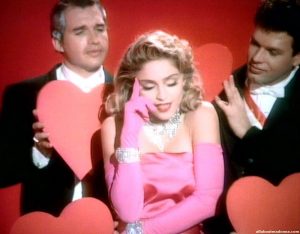Sustainability, sustainability everywhere.
That could be the incipit of the nightmare of an oil tycoon. Or maybe it is just the reality.
How come that the latest Coldplay music videos are starring more and more natural assets? Why does Jack Johnson ask directly to his fans to commit for the protection of environment?
But above all, what is happened to the Michael Jackson’s Thriller mood of music industry?

We are all intellectual Material Girls
The easy answer to these question is: men are sons of their time.
Hence when Madonna popped up with Material Girl in 1984, asking on the phone for expensive diamonds’ necklaces, wearing a snow white fur (for sure not eco-friendly!) and stealing from the pockets of his various boyfriends, she was just performing an economic analysis! In fact, 1984 the US were experiencing finally a moment of relaxation, after holding a long breath throughout the end of the 70’s with a discrete economic recession and an oil price crisis in ’79. Back then was time for Reagan election, deficit spending and corporate earnings. Sweet sweet 80s.
As a consequence it is natural that music, as a form of art and communication is expressing the human commitment towards the environment. After all, Paris Agreements have reached a major objective: spreading the word of climate change. And Princeton University published a paper estimating that the two major predictors for climate change awareness are education and access to means of communication.
So green music equals good news, isn’t it?
Green Music Washing
Easy answers are often incomplete answers.
Not only art is the result of the historically epoch artist are living in, art is a business.
If not, given the time we are living in our songs should mostly depict and treat fear of terrorism and protection for the environment. Indeed Rihanna released her video Bitch Better Have My Money starring a very much fancy and lush life.
By the way, also Coldplay sponsored the expensive Beats by Dr. Dre Speakers in between their natural videos. Is it just reducing to a commercial strategy, pretending to act green while it is just a marketing move? Certainly not.
However it is an undeniable tendency. Take Coldplay: they were born as an alternative brit-rock band, and now they are hitting the tops with every single, that ultimately, look alike everytime.
From an article of John Harris at The Guardian: after the terrorist attack in NYC of 2001(ndr) “Almost every Coldplay record since has dealt in much the same qualities: reassurance, redemption, an insistence that what it is to be human will somehow see us through…their songs seem to become lighter and more blithely optimistic in direct proportion to the troubled nature of the world. The worse everything gets, in other words, the more they seem driven to reassure us, in language often so banal it beggars belief.”. An addictive pill?
Silver Linings
The United Nations in 2010 established the Music & Environment Initiative which aims to leverage the power of music to address some of the most pressing environmental problems facing the planet, bringing together musicians who want to be part of the solution. So, music is considered also by the of the most influential global institutions part of the solution.
However, the link between environment and music leads us to another bittersweet truth: market is the invisible hand, setting the scene, once again. So listening to green music could be a benefit as it is influencing at least positively contemporary philosophy. Nevertheless one must also check the consistency to this commitment: are the practices of music production sustainable?
Music industry accounted in 2015 for 48.1 billion $ in revenues (Pwc datas); no data on sustainability in this sector are available. Imagine how much of an impact would be making that amount of money sustainably.
To have an hint check out Jack Johnson’s campaign. Making alternative music… is still possible.



